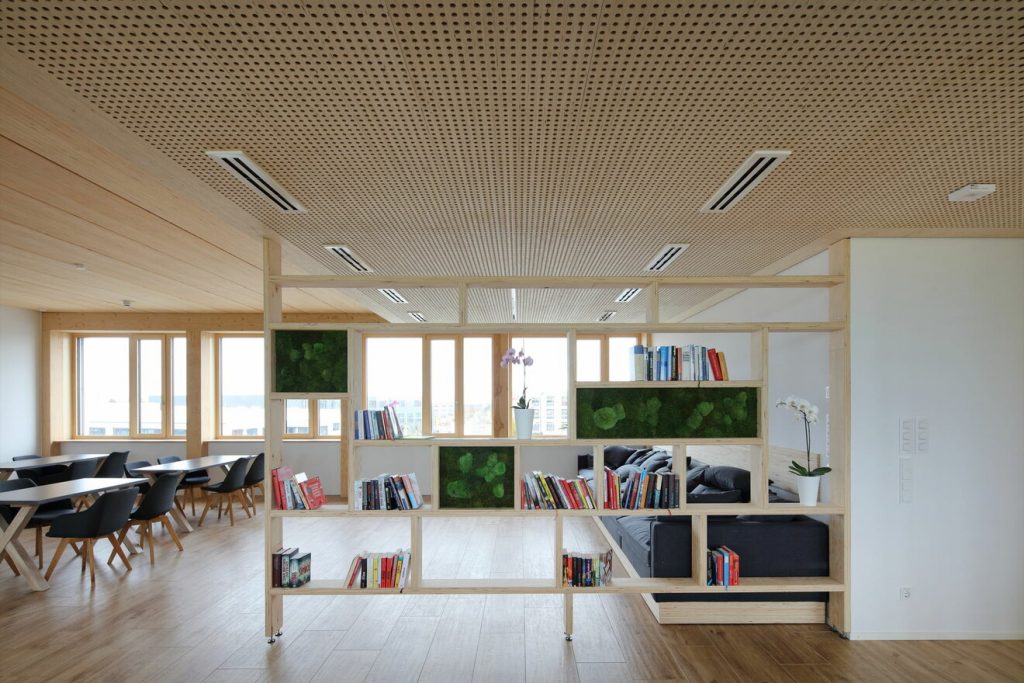The third in our series of articles, written by members of the Beyond Zero Carbon team from STEICO, BSW, MEDITE SMARTPLY and National Timber Group, looks into the health and wellbeing benefits that timber, and natural products generally, can offer when used in buildings.
First we need to think about what we really mean by Health and Wellbeing in the context of buildings.
a state of complete physical, mental and social wellbeing and not merely the absence of disease or infirmity.
Definition of health – World Health Organisation (WHO)1
the state of being comfortable, healthy or happy.
Definition of wellbeing
Health and wellbeing is influenced by the wider physical environment. By addressing the wider determinants of health – including food safety, housing standards, health and safety, air quality, noise and environment issues generally – environmental health makes a fundamental contribution to the maintenance and improvement of public health.
So how do timber products fit into this narrative?
Recent figures show that we spend the vast majority of our time indoors – up to 90% – at home, work or school2. In this respect, the type of buildings we frequent, the materials they are made from and the quality of the air in them can play a huge role in our general health.

Indoor air quality and health benefits
Timber products can help to improve indoor air quality by moderating humidity levels, and the inclusion of wooden interiors has been shown to have significant health benefits. For example, a Japanese study found that exposure to wooden panels significantly decreases blood pressure while, by comparison, exposure to steel panels make it rise3. In another study, workers in offices with wooden interiors conveyed feelings of innovation, energy and comfort, whilst those in offices without wood conveyed feelings of their environment being impersonal and uncomfortable4.
A study conducted in 2010 in an Austrian school compared two ‘timber’ classrooms versus two ‘standard’ classrooms. The benefits for children studying in the timber classrooms were impressive: their heart rates were lowered by up to 8600 heartbeats. The children were also noticeably more relaxed and it had a positive effect on their performance too leading to a decreased perception of stress.
Year-round thermal comfort
Properly specified and detailed timber construction offers year round thermal comfort. This means that the right specification of timber materials can not only keep a building warm during the winter but also keep it cool during the summer. The risks of overheating in our homes, and the associated health risks to the occupants, is only now being realised and these issues will only get worse with rising temperatures brought about by climate change5.
Materials that work together
Carefully considered specification can also take into account the overall functionality of a building by utilising a ‘Fabric First’ approach. This maximises the performance of the materials used within the building envelope and ensures that they work in conjunction with each other, offering a holistic solution.
Utilising timber for the bulk of the materials ensures they work together better: timber-to-timber connections for example are much quicker and easier to incorporate than timber to steel. This approach means that important aspects of a building’s specification, such as ‘air-tightness’, ‘vapour control’ and ‘breathability’ can all work together. Put in conjunction with natural and mechanical ventilation ensures the long term durability of the building fabric6 and the health of the occupants.
Human health and the health of the planet are not mutually exclusive. They are intrinsically linked. The use of natural and sustainable construction materials like timber can ensure both a healthy internal climate and a healthy planet.
Further reading
- Wood For Good: Facts about Health and Wellbeing in the built environment
- Trada: Role of Wood in Healthy Buildings
- The advantages of timber in construction: environment
1 source: https://www.who.int/activities/promoting-health-and-well-being
2 source: https://www.blf.org.uk/support-for-you/indoor-air-pollution/about-indoor-air-pollution
3 source: https://link.springer.com/article/10.1007/s10086-004-0643-1
4 source: https://woodforgood.com/why-choose-wood/health-and-wellbeing#
5 source: https://www.zerocarbonhub.org/sites/default/files/resources/reports/ZCH-OverheatingEvidenceReview-Impacts.pdf
6 source: https://asbp.org.uk/briefing-paper/airtightness-vapourcontrol-breathability
